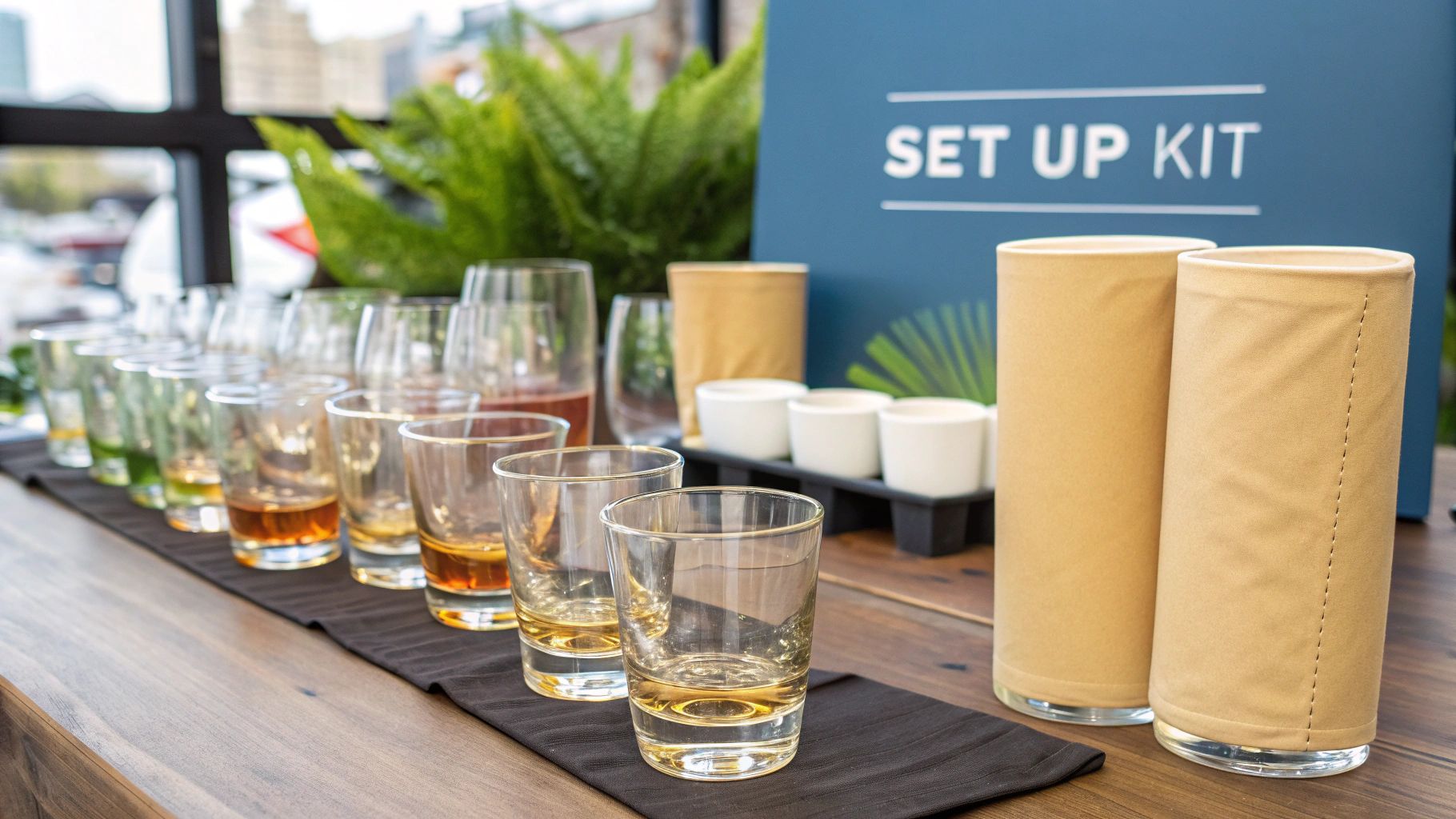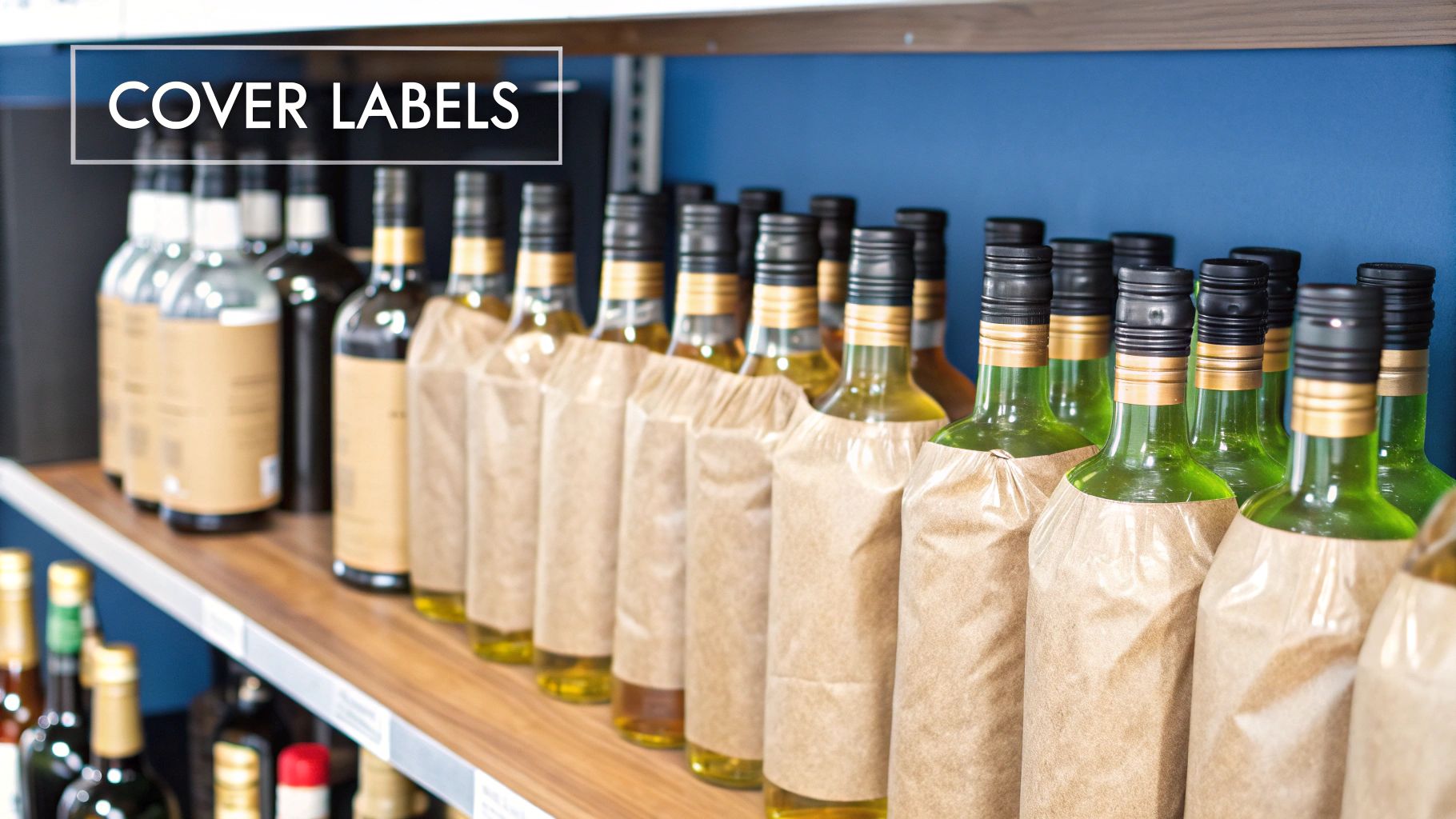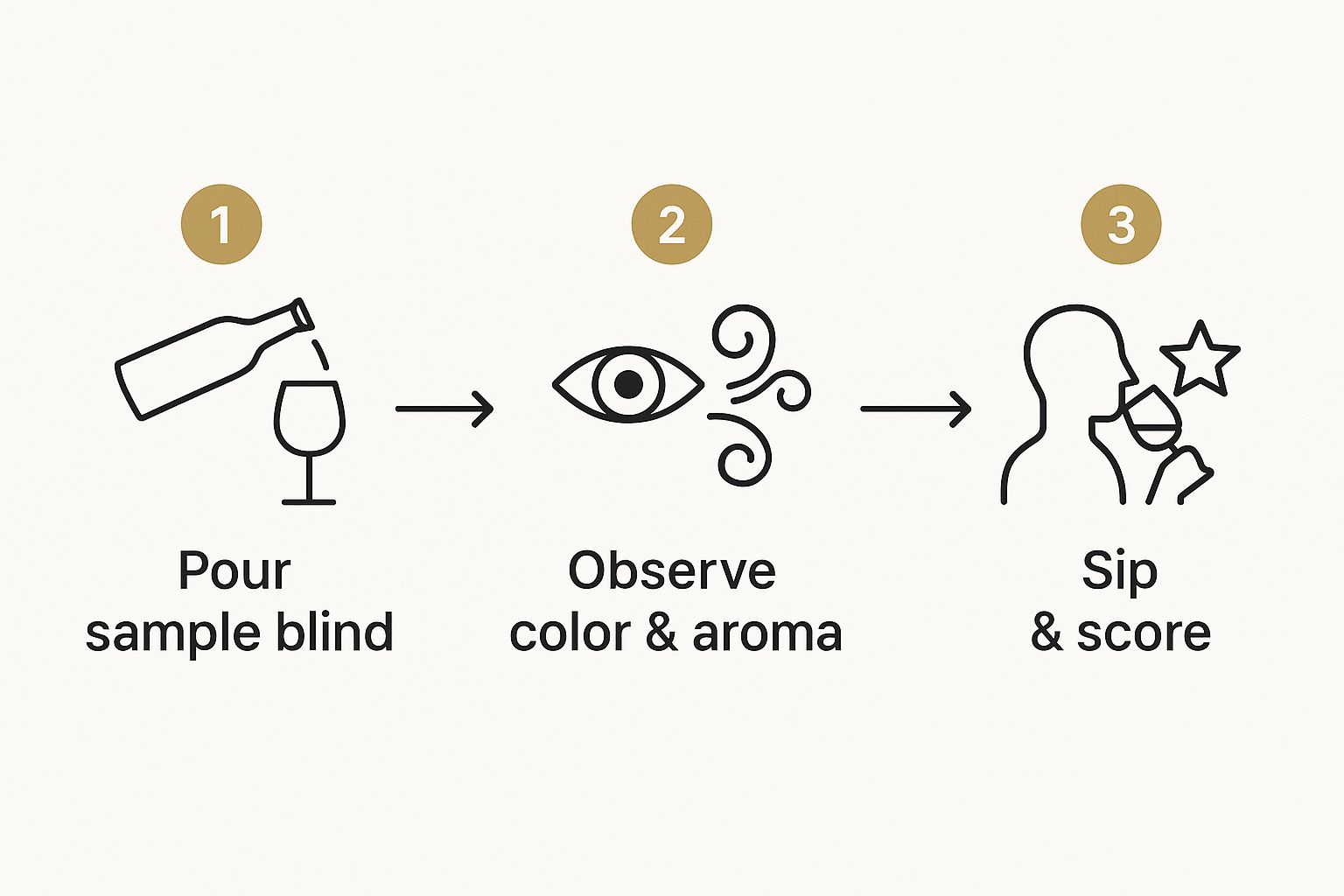A blind whiskey tasting kit is your secret weapon for discovering new spirits based purely on what’s in the glass, not what’s on the label. Inside, you'll typically find several numbered, unlabeled whiskey samples, along with tasting notes and a guide for the big reveal. This whole setup is designed to remove brand bias, making your palate the one and only judge.
Why Blind Tasting Is the Best Way to Explore Whiskey
Picture this: you pour a dram of whiskey, taking in its complex aromas and rich flavors. You form a genuine opinion without ever seeing the bottle it came from. That’s the magic of blind tasting. It completely strips away the influence of fancy packaging, famous brand names, and intimidating price tags, forcing you to trust your own senses.
It's the most honest, unfiltered way to figure out what you truly enjoy.
An at-home blind whiskey tasting kit brings this entire experience right to your doorstep, whether you're a curious newcomer or a seasoned pro. These kits are built to be both educational and entertaining, turning a simple drink into a full-on sensory adventure.
Discover Hidden Gems from American Craft Distilleries
Many of the best subscription kits have a real passion for showcasing small, independent American craft distilleries. We're talking about passionate, often family-run operations making incredible whiskey that you'll never find on the shelf at your local liquor store. A good kit will often feature these unique American craft whiskey brands, giving you access to spirits with real stories behind them.
A blind tasting is the perfect way to meet these hidden gems, letting the quality of their spirit do all the talking. You might just find your next favorite bourbon comes from a tiny town in Texas, or that you have a soft spot for rye from Pennsylvania.
This curated approach has really taken off. For instance, services like Blind Barrels offer quarterly subscriptions that deliver unlabeled samples of hard-to-find craft whiskeys, bringing these unique spirits to a much wider audience.
A Perfect Starting Point for New Whiskey Drinkers
If you're just getting into whiskey, the sheer number of choices on the wall of a liquor store can feel paralyzing. A blind tasting kit acts as your personal guide, offering a structured yet totally relaxed way to learn the ropes. Kits often give tips for new whiskey drinkers, making the experience welcoming and fun.
The goal isn't to become a professional critic overnight. It’s about exploring and building your own confidence. You learn to pick out basic notes—is it sweet like caramel, spicy like cinnamon, or smoky like a campfire?—without any pressure to get it "right."
This process is fantastic for building a personal flavor vocabulary. You’ll start to notice patterns in what you like, which is invaluable information for the next time you're looking to buy a bottle. Instead of just guessing, you'll know that you tend to prefer wheated bourbons or rye whiskeys with a particular kind of finish.
It’s easily the most effective and enjoyable way to train your palate and become a more discerning drinker.
Before we get into the "how-to," let's quickly break down what you should expect to find inside one of these kits.
Key Elements of a Blind Whiskey Tasting Kit
A well-designed kit is more than just a box of whiskey. Each component serves a specific purpose to guide you through the experience, making it fun and educational, especially for newcomers.
| Component | Purpose | Benefit for Beginners |
|---|---|---|
| Numbered, Unlabeled Samples | To conceal the whiskey's identity, removing brand bias. | Allows you to focus purely on taste and aroma without preconceived notions. |
| Tasting Journal or Cards | Provides a structured way to record your sensory notes. | Helps you learn to identify and describe flavors, building your "tasting memory." |
| Guided Instructions | Offers a step-by-step process for tasting and evaluation. | Takes the guesswork out of the process and makes it feel less intimidating. |
| Reveal Information | Contains details about each whiskey (distillery, age, mash bill). | Connects your tasting experience to the whiskey's background, enhancing learning. |
| Tasting Mat | Organizes your glasses and notes for a clean, professional setup. | Keeps everything tidy and helps you track which sample is which. |
Ultimately, these kits are designed to be an all-in-one package, giving you everything you need to host a successful and insightful tasting right out of the box.
How to Choose the Perfect Whiskey Tasting Kit

Alright, this is where the fun really begins. Picking the right blind whiskey tasting kit is your first—and most important—step toward a killer event. You'll find everything from one-off boxes to quarterly subscriptions, so the real question is: what kind of experience are you trying to create? Are you aiming to explore a specific region, or are you up for a totally random adventure?
I've found that the most memorable kits are usually built around a theme. It could be a deep dive into a single style, like bourbon or rye, or maybe a geographical tour. Kits that spotlight American craft distilleries, for example, are a fantastic way to discover amazing spirits you'd probably never stumble upon on your own. This kind of focus gives the whole experience a cohesive and educational feel for everyone at the table.
There's a massive appetite for these guided tasting experiences. In fact, the global Whisky Cask Tasting Experiences market was recently valued at around USD 1.47 billion, which shows just how much people want to learn and explore. Subscription kits are a direct response to this trend, bringing that curated discovery right into your living room. You can dig into the numbers yourself with this recent market analysis on DataIntelo.
Judging a Kit’s Quality and Content
Look, not all kits are created equal. A few small details can make a world of difference in how your night goes, especially if you have newcomers in the group. The best kits I've seen offer more than just whiskey—they provide a whole guided experience.
Here are a few things I always look for:
- Generous Sample Sizes: Make sure the samples are at least 50ml (1.7 oz). That's a solid pour for one person or just enough for two people to get a proper taste.
- Helpful Materials: Keep an eye out for extras like a tasting mat, guided notes, or a flavor wheel. These tools are gold for helping new whiskey drinkers find the words for what they're smelling and tasting.
- Focus on Craft: When a kit features small, independent American craft distilleries, it's usually a good sign. It shows a genuine passion for sourcing unique, high-quality spirits that tell a story.
A great kit doesn't just send you whiskey; it gives you the tools to understand it. For a beginner, a simple flavor wheel can be the difference between feeling lost and having that "aha!" moment when you identify a note of caramel or black pepper.
The Reveal What’s Your Style
Finally, think about how the kit handles the big reveal—that moment when everyone finds out what they've been drinking. The method should match the vibe you're going for.
Some companies stick with sealed envelopes, which adds a bit of classic, analog charm to the whole thing. Others, like Blind Barrels, take a more modern route with a QR code on each sample. A quick scan pulls up everything you need to know: tasting notes, the distillery's backstory, and even videos. It makes the reveal interactive and super informative.
Choosing a kit with a reveal style that gets you excited is the final piece of the puzzle for a successful tasting night.
Setting the Scene for Your Tasting Night

With your blind whiskey tasting kit in hand, it’s time to shift from curator to host. The right atmosphere is what separates a simple tasting from a truly memorable night, making your guests feel relaxed, curious, and ready to explore. You’re essentially creating a sensory-neutral space where the whiskey can be the undeniable star of the show.
Think of it like setting the stage for a great performance. You need to dial back anything that might compete with your guests' palates or sense of smell. That means picking a room with good, clear lighting so everyone can appreciate the rich colors of each spirit. It also means nixing any strong ambient odors.
Before your friends arrive, hold off on lighting those scented candles, cooking aromatic foods, or spraying strong air fresheners. These can easily steamroll the delicate notes in a whiskey, making it much harder for everyone—especially the newcomers—to pick out those subtle aromas. A clean, fresh-smelling space is your best friend here.
Assembling Your Tasting Essentials
Your kit has the whiskey covered, but a few extra items will elevate the whole experience. Getting everything laid out beforehand means the evening flows smoothly, keeping the focus on discussion and discovery—not on a frantic search for a missing pen.
Here’s a quick checklist for your tasting table:
- Proper Glassware: A tulip-shaped glass, like a Glencairn, is the gold standard for a reason. It’s specifically designed to concentrate the whiskey's aromas. If you don't have a set of Glencairns, any glass with a wide bowl that tapers to a narrower rim will do the trick.
- Palate Cleansers: Simple, unsalted crackers or slices of plain baguette are perfect. They reset the taste buds between samples without leaving behind any distracting flavors. Save the cheese and charcuterie for after the tasting.
- Hydration Station: Have plenty of room-temperature water on hand. It’s useful for cleansing the palate and for guests who want to add a few drops to their whiskey to open up the flavors.
- Tasting Notes: Make sure every guest has a pen and either a tasting mat or a small notebook. Most kits include these, but it’s always smart to have extras. Encouraging people to jot down their immediate thoughts is the secret to sparking a lively conversation later.
But the most important thing you can provide? A welcoming, pressure-free attitude. Remind everyone, especially those new to whiskey, that there are no wrong answers here. The goal is just to share what you’re sensing, whether it's a note of vanilla, a hint of campfire smoke, or a random memory of fresh-cut grass.
Creating a Comfortable Vibe
Once the supplies are ready, shift your focus to comfort. You don’t need a stuffy, formal setup; a cozy living room or your dining table is perfect. Just arrange the seating so everyone can easily see and chat with each other. It’s all about creating a sense of community.
This is especially important for making beginners feel at ease. A lot of people are intimidated by whiskey tasting, worried they don't know the "right" words to use. A relaxed, conversational setting empowers them to trust their own senses and just have fun with it.
Featuring interesting American craft whiskeys can also be a fantastic icebreaker, since they're often new to everyone in the room and put everyone on a level playing field. For more ideas on making your event a hit, check out our guide to hosting a fantastic at-home whiskey tasting that your friends will be talking about for weeks.
How to Taste Whiskey Like an Expert
Alright, this is where the real fun begins. Your blind whiskey tasting kit is open, the glasses are set out, and your friends are looking at you, ready for the main event. Now it's your turn to guide them through the process of actually tasting the whiskey.
Don't feel like you need to be a professional critic. The whole point is to break down the experience into simple, fun steps that help everyone trust their own senses and discover what they like. It’s all about a simple four-part method: looking, swirling, smelling, and finally, tasting. Each part of the process tells a piece of the whiskey's story, especially with the unique American craft whiskeys in your kit.
This little diagram is a great way to visualize the flow for each sample.

Following this simple path from pouring to scoring keeps things consistent and helps everyone focus on one whiskey at a time.
Look and Swirl
First things first, have everyone hold their glass up to the light. The color alone can drop hints about the whiskey's age or the kind of barrel it matured in. Is it a pale straw color? A rich gold? Or a deep, dark amber?
Next, give the glass a gentle swirl. Watch how the liquid clings to the sides and runs back down. We call these streaks "legs" or "tears," and they can give you a clue about the whiskey's body and alcohol content. Thicker, slower legs often mean a higher proof or a richer, oilier mouthfeel is coming your way.
Nosing the Aromas
This might be the most important step of all. Your sense of smell accounts for a massive part of what you perceive as taste. You don’t want to just stick your nose right in the glass, though—that's a surefire way to get an overwhelming blast of alcohol.
Instead, try this technique, a great tip for new whiskey drinkers:
- Ease into it: Start with the glass down by your chest and slowly bring it up toward your chin.
- Keep your mouth open: It feels a little weird at first, but this lets the harsh alcohol vapors escape while the more delicate aromas make their way to your senses.
- Take short, gentle sniffs: Try alternating nostrils. What do you pick up? Is it sweet like vanilla or honey? Fruity like apples? Spicy like cinnamon?
Remind your guests there are absolutely no wrong answers here. One person might smell baked bread while their friend gets fresh-cut grass from the same glass. It's all about personal association, and that’s what makes the conversation so interesting.
The Sip and the Kentucky Chew
Finally, it’s time for a taste. The first sip can be a bit of a jolt, so a great tip for new whiskey drinkers is to take a tiny one to get your palate ready.
For the second, more meaningful taste, introduce your group to the "Kentucky Chew." It's a classic for a reason. Take a slightly bigger sip and gently swish it around, almost like you're "chewing" on it for a few seconds. This makes sure the whiskey coats your entire mouth, unlocking a whole spectrum of flavors from the moment it hits your tongue to the lingering finish.
If you want to dive even deeper, our comprehensive guide on how to taste whiskey has more tips and tricks to help you train your palate.
Identifying Common Flavors
As you and your guests start tasting through the samples, you’ll notice certain themes popping up. It can be super helpful, especially for beginners, to have a little cheat sheet to help put a name to what they're experiencing.
Here’s a quick reference table of some typical flavor profiles you’ll run into.
Common Whiskey Flavor Profiles to Identify
| Flavor Category | Example Notes | Often Found In |
|---|---|---|
| Sweet & Caramels | Vanilla, Honey, Brown Sugar, Toffee | Bourbon, Wheated Whiskeys |
| Fruity & Floral | Apple, Cherry, Orange Zest, Pear, Rose | Single Malts, Finished Whiskeys |
| Spicy & Herbal | Cinnamon, Clove, Black Pepper, Mint, Tobacco | Rye Whiskeys, High-Rye Bourbons |
| Woody & Nutty | Oak, Cedar, Almond, Walnut, Toasted Pecan | Well-aged Whiskeys, American Oak |
| Smoky & Earthy | Campfire, Leather, Peat, Charred Oak | Peated Scotch, some American Single Malts |
Encourage everyone to call out what they find. You’ll be amazed at the different notes people pick up from the exact same whiskey. Honestly, that discovery is the real magic of doing a blind tasting.
Leading the Discussion and the Grand Reveal

This is where you, as the host, really get to shine. A truly great tasting isn't just about the whiskey—it's about shared discovery. Your job is to get the conversation flowing, and the best way to do that is by asking simple, open-ended questions that invite personal opinions, not technical jargon.
You absolutely don't need to be a whiskey expert to moderate. In fact, sometimes it’s even better if you aren’t! Your main goal is simply to create a fun, inclusive space where even the newest tasters feel comfortable sharing what they're experiencing. A few good prompts can make all the difference.
Sparking a Lively Conversation
To get things started with each new sample, go around the table and ask a few engaging questions. This pulls everyone into the experience and gets them comparing notes, which is really the heart and soul of any blind tasting.
Here are a few conversation starters I've found work really well:
- "Before you look at any notes, what's the very first thing that pops into your head when you smell this?"
- "If you had to place this on a scale from sweet to spicy, where would it land for you?"
- "Does this whiskey remind you of a specific food or maybe even a memory?"
- "How about the finish? Is it long and lingering, or does it end pretty quickly?"
These prompts are intentionally low-pressure. They encourage people to use their own words, which is perfect when your blind whiskey tasting kit features unique American craft whiskeys that often defy the usual categories.
Remember, the goal is participation, not perfection. The most memorable moments happen when someone says a whiskey smells like their grandfather's workshop or tastes like a specific dessert they had once.
There's real power in this process. Removing the bias of a label is an incredible educational tool. A tasting by the Houston Bourbon Society, for example, highlighted how blind evaluations sharpen everyone's ability to assess qualities like flavor and proof, free from the influence of a famous brand.
The Grand Reveal Moment
After everyone has had a chance to taste and talk through all the samples, it’s time for the moment everyone's been waiting for. The big reveal is the climax of the evening, so really make it a moment!
Unveil the identity of each whiskey one by one. Give each spirit its own time in the spotlight. As you reveal a bottle—maybe an unexpected single malt from California or a bold rye from Pennsylvania, common finds in kits featuring American craft whiskey brands—open the floor for one last round of discussion.
People love comparing their initial impressions to the facts. Was the proof higher or lower than they guessed? Were they totally surprised by the distillery's location or its unique mash bill?
Managing these conversations and keeping the energy high is what separates a good host from a great one. If you want to take your hosting skills to the next level, our official Blind Barrels Whiskey Moderator journal is the perfect sidekick to help you organize your thoughts and guide the discussion like a seasoned pro.
Got Questions About Your Blind Whiskey Tasting?
So, you've got your hands on a top-notch blind whiskey tasting kit, and the excitement is building. But even with everything you need right in front of you, it's totally normal for a few questions to pop up, especially if you're playing host for the first time.
Let's walk through some of the most common queries I hear. From tasting lingo to the perfect group size, these quick answers will have you feeling like a seasoned pro in no time.
What If I Don't Know Any Fancy Tasting Terms?
Perfect! In fact, that's the best way to come into this. A blind tasting is all about your genuine experience, not showing off with complicated jargon. The real goal is just to put words to what you're smelling and tasting, using whatever references make sense to you.
Does a whiskey remind you of fresh-cut apples, your grandma's holiday baking, or maybe that caramel corn you get at the state fair? There are no wrong answers here. Many kits, particularly those shining a light on American craft whiskey, come with handy tools like flavor wheels or tasting notes to get you started. You’ll be surprised how quickly your confidence and vocabulary grow with each new spirit you explore.
The single most important piece of advice for new whiskey drinkers is to trust your own palate. If you taste cherry, it’s cherry. If you smell leather, it’s leather. This is about exploration and conversation, not passing a test.
How Many People Should I Invite?
If you're aiming for that perfect balance of lively conversation and personal reflection, the sweet spot for a great tasting is somewhere between four and eight people.
This size is ideal. It’s small enough to ensure everyone gets a chance to share their thoughts without feeling rushed or talked over. But it’s also large enough to spark a fun, diverse range of opinions. For your very first event, keeping it cozy with a group of four to six is a fantastic way to ease into hosting.
What's the Best Way to Handle the Big Reveal?
You'll want to save the grand reveal for the end. It’s the climactic moment of the whole experience, so have some fun with it! Once everyone has finished tasting and jotted down their final thoughts on all the samples, go through them one by one.
Announce the identity of the first whiskey, and then immediately open the floor for discussion. This is where the magic really happens, as people compare what they thought with what’s actually in the glass.
- Were they shocked by the distillery's location?
- Did an unknown American craft whiskey end up being the crowd favorite?
- How close did anyone get to guessing the proof or style?
Revealing each one sequentially builds suspense and gives every unique whiskey its own well-deserved moment in the spotlight.
Ready to host an unforgettable tasting experience? The Blind Barrels subscription delivers rare and exceptional American craft whiskeys to your door, complete with everything you need for the perfect blind tasting.
